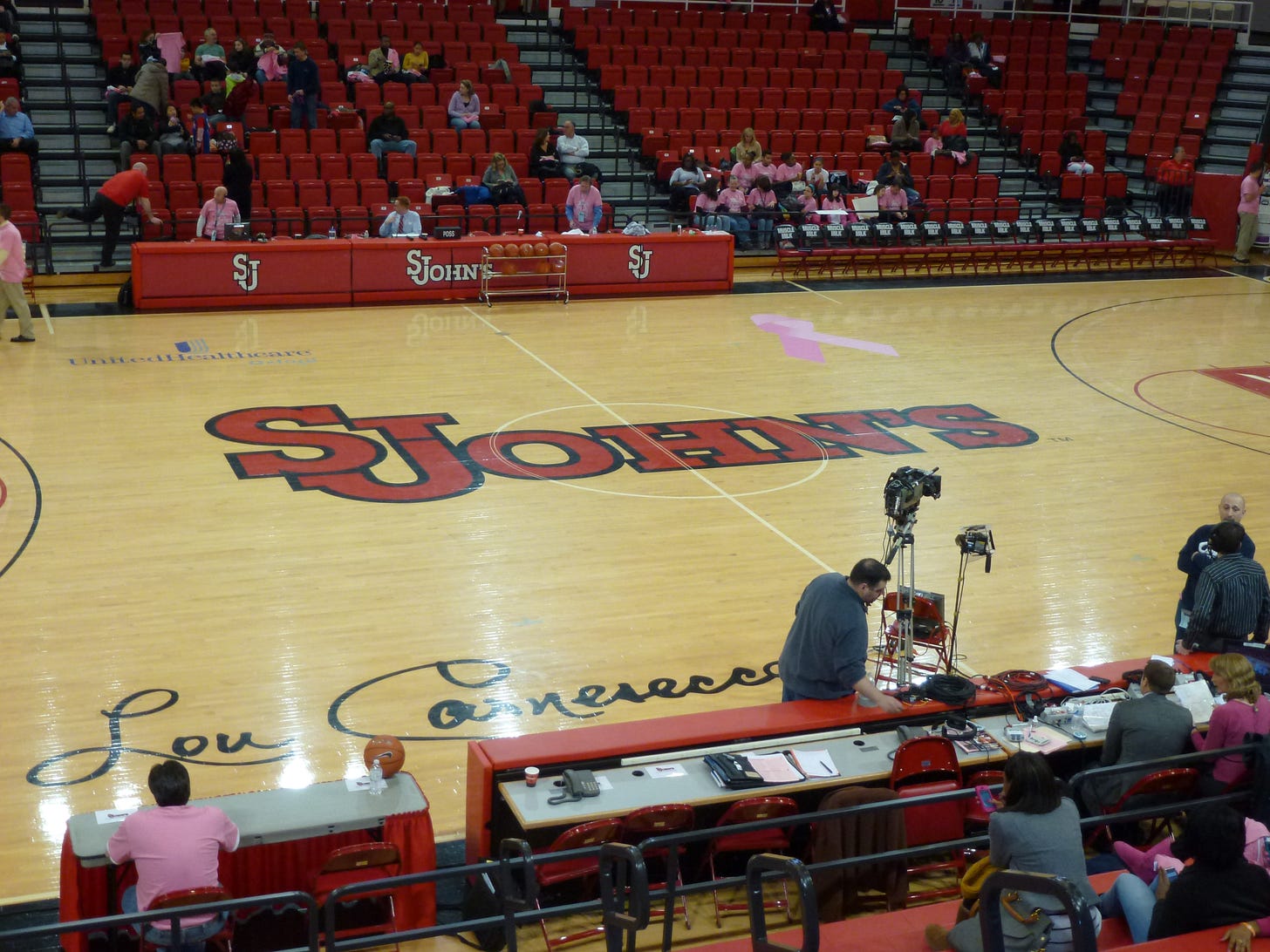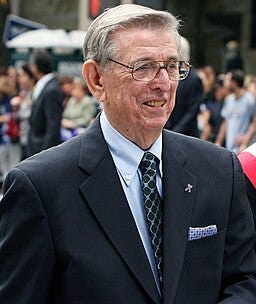It’s hard to find something new to write after all the tributes in the last 24 hours following the passing of former St. John’s University men’s basketball coach Lou Carnesecca. The coach died just a few weeks short of his 100th birthday, and what a life it was. If you grew up in the greater New York City area and you loved basketball, you knew about Coach Carnesecca and you probably loved him too. I know I did, ever since I went to campus at St. John’s in the winter of 1981 to see the Redmen take on the Hoyas of Georgetown University at Alumni Hall in Queens.1
St. John’s put away a 68-60 win that night, and I was hooked. Those were the early days of The Big East conference, an enterprise that amounted to a poke in the eye of the college basketball establishment. The idea was simple: why should high school basketball players coming out of Boston, New York, Philadelphia and Washington, DC have to go elsewhere to live out their college basketball dreams when they could stay close to home and play in front of friends and family? It was a simple idea that worked very, very well, at least for a time.
From the founding of the conference in the late 1970s, it was a glorious thing, and Coach Carnesecca was in the middle of it all, battling with other legendary coaches like Georgetown’s John Thompson, Villanova’s Rollie Massimino, Seton Hall’s PJ Carlesimo, UConn’s Jim Calhoun and Syracuse’s Jim Boeheim for the conference title all the way to the Big East tournament every March at Madison Square Garden.
It was never better than in 1985, when St. John’s, Georgetown and Villanova filled three of the spots in the Final Four in Lexington, Kentucky, with Boston College coming two victories away from making it an all-Big East party. In the main hallway of my high school, guidance counselors hung posters asking, “Have you thought about applying to a Big East school?”2
I did, and a few hundred of my classmates did too, as did kids all over the East Coast, flooding admissions offices with applications from students who otherwise might not have considered those schools if not for the conference and its basketball teams.
I had a more personal connection to Coach Carnesecca. Before serving in the Coast Guard in World War II, the coach attended St. Ann’s Academy in Manhattan, an all-boys Catholic private school. After the war, Coach Carnesecca returned to the school and took over as head coach of the basketball team, and then relocated to Queens when the school was gifted a new campus in Jamaica by Brooklyn Archbishop Thomas Edmund Molloy. As a way of saying thanks, the Marist Brothers who ran the school renamed it after the archbishop, and the school opened in the new location at the corner of Main and Manton Streets in time for the 1957-58 academic year.3
The coach, who had already built St. Ann’s into a basketball powerhouse, did the same in Queens, leading the squad to a 32-0 record, as Archbishop Molloy was generally acknowledged to be the best high school basketball team in the USA. In between games, Coach Carnesecca taught physical education, which is where he met my father. He was part of the first freshman class to enroll at Molloy.4 But the coach wasn’t there long, as his success attracted the attention of Joe Lapchick, then head basketball coach at St. John’s. Carnesecca left Molloy after a single year to become an assistant under Lapchick, and took his best players with him.5 After that, it was only a matter of time before Carnesecca took over for Lapchick.

It was a few months after watching “The Johnnies” at Alumni Hall for the first time that I got to meet the coach in person. The following Summer, I still had some delusional hopes about playing competitive basketball as a high schooler, and convinced my parents to send me to the Eastern Invitational Basketball Camp, which was run by Long Island resident and former ABA player George Bruns. He had played for Carnesecca during a 13-game stretch in his only season with the New York Nets during the coach’s brief sojourn from St. John’s, but I guess Coach Carnesecca liked him because at the end of the week, Coach Carnesecca drove from Queens to the campus of Trenton State College6 where the camp was held to say a few words at the awards ceremony that officially ended our stay.
My father, who expertly treads the line between mensch and nudge, couldn’t help but chat up the coach, and remind him of that single season at Molloy when the coach was his gym teacher. Carnesecca, who went out of his way to make time for seemingly anyone who asked, was happy to chat with us for a few minutes. He was friendly, kind and patient with a shy teenager who wasn’t comfortable being in the spotlight, never mind meeting privately with a New York sports legend like Coach Carnesecca.
I was grateful I had chance to meet him. And given the tributes we’ve seen overnight, I wasn’t the only one. I’ve seen the coach quoted as saying that whenever he met God, he knew the almighty wasn’t going to be interested in how many basketball games he won. That was exactly the man I met. And as great as he was on the basketball court, he knew what really mattered.
Bravo Zulu, coach. Fair winds and following seas.
It wouldn’t be until years later that the school changed the name of their teams to the Red Storm, and Alumni Hall gave way to the Lou Carnesecca Arena.
Doug Flutie helped a lot too.
During the 1961 MLB season, Roger Maris, Mickey Mantle and Bob Cerv of the New York Yankees shared an apartment in the same neighborhood that overlooked the school’s baseball field.
I would follow my father there in 1981, graduating in 1985.
Before Carnesecca left Molloy for St. John’s, he arranged for Jack Curran to become head basketball coach. That worked out very well.
Today it’s known as The College of New Jersey, but that week we all called it Trenton State Penitentiary. You had to be there.






Great story. Those Big East days were the best ... I went to the Big East tournament one year at MSG in the late 80's. My brother lived in Queens, and we adopted St. Johns as our college basketball team ... good times.